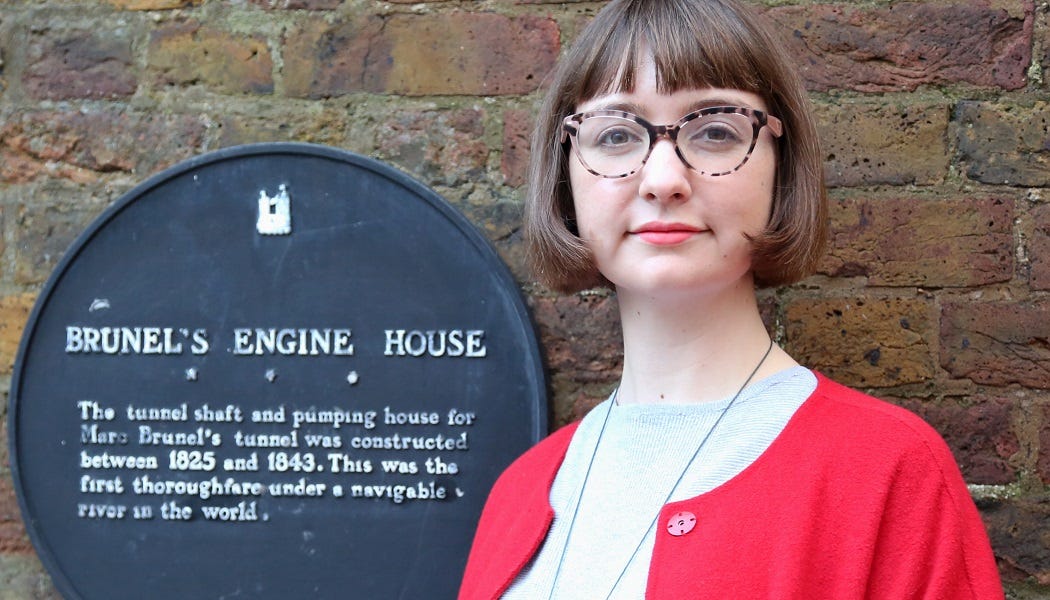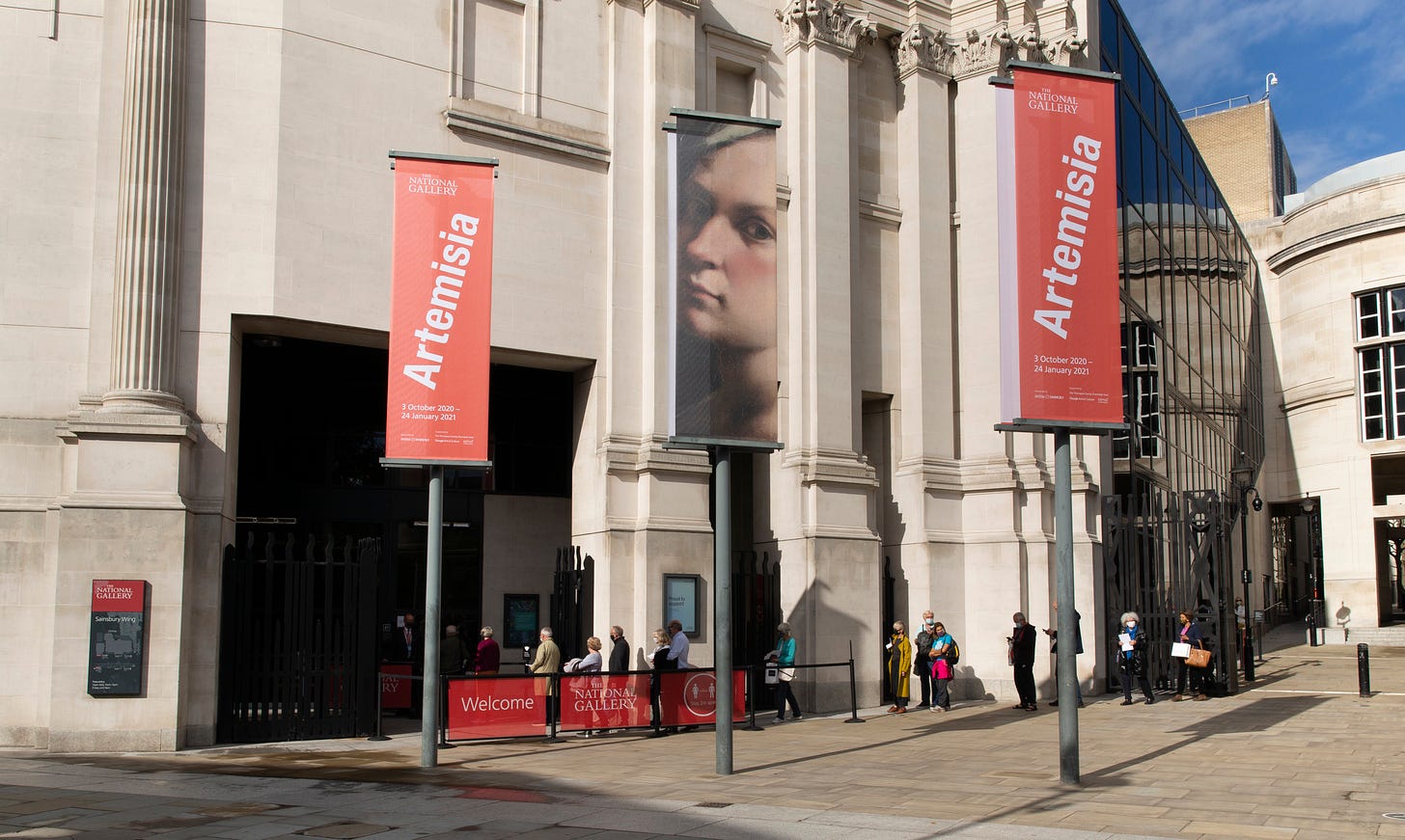Interview: New Director of Brunel Museum
Katherine McAlpine takes the reins in the most unprecedented of times
maxwell museum magazine - 17 February 2021
Hello - to all 700+ of you! Yes this edition comes to you shortly after I hit a seventh century of subscribers. I am grateful to each and every one of you who have signed up, and I keep writing because you keep reading. I hope I am fulfilling my mission of bringing you museum news + inspiration in a fun, snappy and lighthearted way.
This is the fortnightly magazine edition of my newsletter which means it’s my regular features, including an interview. This time I’ve spoken to Katherine McAlpine, the new Director of the Brunel Museum. It’s one of London’s real gems and I even included it in a round-up of London’s best small museums that I wrote for National Geographic Traveller. I was massively keen to find out what it’s like taking on your first Director role in the middle of a global pandemic. Read on to find out!
Love museums? Then you’ll love my newsletter. I send a round up of museum news every Friday, and every two weeks a jam-packed edition of original features including interviews. Subscribe to get the next edition.
barometer
What’s heating up and cooling down in the world of museums this week.
going up ⬆️
The culture wars. These are definitely heating up this week as the Culture Secretary has asked 25 of the UK's biggest heritage charities, museums and art galleries to a round table meeting where they will be told to stop trying to "airbrush" history and to “defend our culture and history from the noisy minority of activists.” I’m sure this will all end just swimmingly.
going down ⬇️
Relations between the Royal Academy and Gilbert and George (although from the sounds of it, these went south a fair while ago…). In an interview with the Times at the weekend, the artist duo called the RA an “elephant’s graveyard” and revealed that they told the Academy a decision to cancel their promised exhibition was “clearly that of jealous provincial bigots”. Off the Christmas card list I expect.
what’s on
With museums and galleries across the UK and much of Europe still closed, here’s 3 of the best online exhibitions currently showing at commercial galleries.
Rachel Kneebone at White Cube online - Recent sculptures in Kneebone’s trademark white porcelain which focus on dynamic movement and fragments of the human form
Stan Douglas’s Penn Station’s Half Century at David Zwirner online - Ambitious photographic work reconstructing nine forgotten moments from history that took place at Pennsylvania station in New York City
Martin Creed: Three Toasts and Some Broccoli at Hauser and Wirth online - The unveiling of a new neon is the perfect excuse for Hauser and Wirth to pull together a new show of entertaining, shocking and beautiful works


interview
Being a museum director can be a challenge at the best of times. Right now though, we’re in the worst of times so ‘unenviable’ might be a more apt description of the top job. Museums have seen collapsing revenue due to rolling covid-closures, and many are fighting for their very survival.
But Katherine McAlpine is undaunted. She’s just started as Director of the small but wonderful Brunel Museum on the south side of the Thames in London, and will steer the organisation through the uncertainty of the next year and beyond. On appointing her, the Chair of the Museum’s Trustees praised her “enthusiasm and experience” that she brings from her role as Exhibitions and Interpretation Manager at Imperial War Museums.
She’s been in the role just a handful of weeks but she spoke to me about her plans for the Museum, her desire to focus on local residents, and revealed that inclusivity is top of her priority list.
***
Congratulations on the new job. What's it like taking the reins of a whole museum?
Thank you very much! It’s funny actually because I don’t even have my own set of keys yet! And with the lockdown, it sort of felt for a few weeks like the museum was an abstract concept rather than something with bricks and mortar, and objects and people. But that has actually given me the space to think about what the museum should be, and who it should be for. It’s allowed me to really live my values that museums are about people, not stuff.
Did you always want to become a museum director, and were you actively looking for this type of role?
I’m a bit like a shark in that if I stop moving, I’ll die. So I’m always looking for new and different experiences. A few years ago I took part in the fantastic engage Extend leadership course which really made me want to be a leader. I remember completing that course and saying, in 10 years I’m going to be a museum director. But in February 2020, I was the brilliantly foresighted person who gave up a permanent contract for a maternity cover just before a global pandemic. Rather than actively looking, I was more wondering if there’d be any jobs at all, let alone a leadership role. So when it did come up, I knew I had to take the plunge and go for it.
What was your pitch to the selection committee for why they should give you the job?
My pitch was actually influenced a lot by my experiences of COVID-19 and the lockdowns. Suddenly when your world has shrunk to only places you can get to on your own two feet, you experience your world differently. I felt that when I did return to work I wanted to make sure that museums embraced that new perspective. And the Brunel Museum felt like exactly the kind of place where I was pushing at an open door to be able to take such a hyper local approach.
You've said that the museum is "fighting to secure our financial future." How are you looking to do that and are you having to make cuts?
Across the museum and heritage sector, the story is the same. Like so many, we rely on our ticket income, our shop income and income from our events. So no events, no shop, no visitors, no income. We’re so, so lucky to have received an Arts Council Culture Recovery Fund grant, which has been a lifeline. It’s given us the breathing space to set up new processes, and diversify our income which we so badly needed. So we’ve been able to improve our facilities for venue hire for both commercial photography, and hopefully events if we’re ever able to have live events again. We’re currently looking for a catering partner to run a mobile food stand on our beautiful riverside Piazza. And we’re looking at new ways to reach audiences remotely, through audio walking tours of the Rotherhithe area and a new online escape room we’re commissioning.
Who do you see as the museum's main audience?
For me our audience is our community, and that is specifically our local community. Anyone who can reach us with their own two feet is part of our gang, and we want everyone in the local area to know that they are welcome.
One of your priorities is making the museum more inclusive. How are you doing this, and what are the unique challenges of doing this at a small museum?
The absolute first thing is that Inclusivity is our number one value. So every time we have a decision to make about anything, the first question is ‘Is this as inclusive as it possibly can be?’ What are the barriers here?’ And that value has been signed off by the Trustees and is supported throughout the organisation.
Alongside that, we know we have to start with ourselves and recognise what privilege we bring into situations. Because of this, the entire trustee board and all our staff are having training about acknowledging our privilege. That’s in a couple of weeks and I expect a really clear action plan will come from that.
How will you judge the success of your directorship?
So at the moment the most frequent thing people say to me when I tell them where I work is, ‘Oh I didn’t realise there was a Brunel Museum in London!’ so obviously the first measure of success would be for people to say, ‘Oh the Brunel Museum! I’ve been there, I felt so welcome’.
Our mission is to inspire audiences to build a better world for everyone, which is a fairly lofty aim, but one I truly believe in. The Thames Tunnel was built because Marc saw a problem - that London Bridge was delaying the movement of goods - and he came up with a really ingenious solution. His son, Isambard, who worked on that project went on to build so many things that have changed the shape of Britain, solving problems like ships needing to refuel on long voyages. I want to take that problem solving spirit, and help our visitor apply some of that ingenuity to the many problems we’re facing at the moment.
Tell us about your new commission for St Patrick's Day
I’m super excited about this. For me, the story of the Thames Tunnel is not just about the Brunels and their brilliant engineering ideas, its about the hundreds of men who built the tunnel, in often appalling conditions. They worked up to 8-hour shifts, and when they were not working, sometimes they slept in the dark, damp, unfinished tunnel. Floods and explosions from gas lamps were a constant threat. Some of these workers, like Seamus Fitzpatrick, came over from Ireland to find work, and this St Patrick’s Day we wanted to celebrate the contribution of men like Seamus to the Thames Tunnel. We also wanted to reflect on the changing face of our local area, so we worked with Spectrum Drama and the local Irish community in Rotherhithe today to talk about their experiences of migration to London. These reminiscences are going to be turned into a new film, showing how people like Seamus paved the way for later generations of Irish migrants to London.
Why should the Brunel Museum be on everyone's 'to-visit' list when the museums reopen?
At its heart, the Thames Tunnel is a monument to things not going to plan. The project, though ingenious in its design, was beset by issues throughout its construction: floods, death, financial troubles. At one point, the whole project had to be put on hiatus for seven years before they could resume building, but eventually in 1843 it opened to the public for the first time. I think a lot of us can relate to that feeling of things being on pause, and the Thames Tunnel is a story about perseverance, staying power-but also adaptability. And I think we could all use a top up of those particular things right now.
and finally
London’s National Gallery have announced that they will carry out a £30 million makeover of their Sainsbury Wing (a rare sign of confidence amongst the current uncertainty). Opened in 1991 the Sainsbury Wing was hugely controversial, in part thanks to an early insult from the Prince of Wales. In response to the announcement, the Financial Times look back at the turbulent history of this corner of Trafalgar Square, and speak to the original architect of the extension on what she thinks of the plans. Let’s see if the new makeover will have a smoother ride.
Love museums? Then you’ll love my newsletter. I send a round up of museum news every Friday, and every two weeks a jam-packed edition of original features including interviews. Subscribe to get the next edition.





